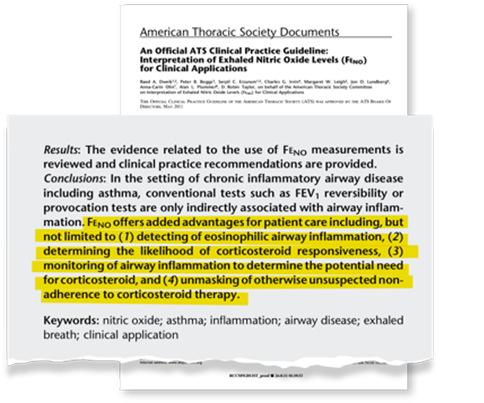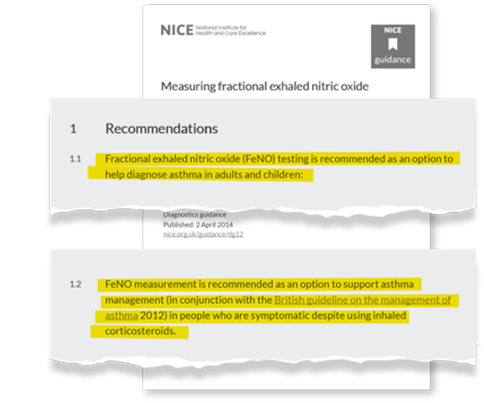Best, when measured against the rest.
FeNO measurements predict steroid response more accurately than other methods, including spirometry, bronchodilator response, or peak expiratory flow variability.1-3
Best, when measured against the rest.
FeNO measurements predict steroid response more accurately than other methods, including spirometry, bronchodilator response, or peak expiratory flow variability.1-3
Essential Facts about Asthma and FeNO
Learn about how FeNO works, or jump to Guidelines
- FeNO is short for Fractional Exhaled Nitric Oxide.
- FeNO is elevated in individuals with allergic asthma.4
- An elevated FeNO is associated with infiltration of eosinophils in the airways.5,6 FeNO elevations are driven by allergic inflammation (Type 2 or Th2) characterized by eosinophilic infiltration and high immunoglobulin (IgE) levels.
- FeNO can be lowered by anti-inflammatory agents.
- FeNO levels fall after treatment with anti-inflammatory medications, such as inhaled corticosteroids (ICS),7 and biologics, such as the anti-IgE monoclonal antibody omalizumab,8,9 but not with bronchodilators.
- An elevated FeNO can predict a good response to ICS.10
- FeNO can be used to diagnose asthma.
- In new patients with symptoms suggestive of asthma, an elevated FeNO can be used to diagnose asthma with high positive and negative predictive values.11
- FeNO can be used to detect nonadherence to ICS.
- In patients with allergic asthma, FeNO can be used to detect nonadherence to ICS treatment, which is a widespread issue.12
- FeNO can be an early sign of worsening asthmatic inflammation.
- A progressively rising FeNO is an early sign of worsening asthmatic inflammation, such as that due to allergen exposure. It can be used to drive proactive preventive measures to prevent asthma from worsening.13
- FeNO can assist in managing difficult-to-control asthma.
- When combined with other management tools, FeNO can assist in managing patients with difficult-to-control asthma.14,15
FeNO testing helps measure airway inflammation severity16
Role of nitric oxide (NO) and FeNO in human health
In the late 1980s, scientists discovered that the human body has complex enzymes, called NO synthases, that synthesize nitric oxide (NO), a ubiquitous gas that diffuses and acts locally on cells to mediate physiologic responses.1 In the vasculature, the effect of NO on smooth muscle results in relaxation and vasodilation, while in the airway, NO results in bronchodilation.
NO binds to receptors on smooth muscle called soluble guanylate cyclase, thereby raising intracellular cyclic GMP, which inhibits the entry of calcium into the cell and relaxes the muscle. In 1998, the Nobel Prize in Physiology or Medicine was awarded to 3 researchers for their role in elucidating the mechanisms of action of NO.²
NO and inflammation
NO is an inflammatory mediator that is produced in large amounts during inflammatory conditions. A reactive species, NO increases oxidative stress when present in large amounts and results in vasodilation in areas of inflammation. In asthma, where there is inflammation of the airways with infiltration of inflammatory cells (e.g., eosinophils), inflammatory mediators, including NO, are produced.
Exhaled NO
NO was first identified in the breath of humans in 1991.3 NO, produced in the airway mucosa by NO synthases, diffuses into the airway lumen and is exhaled. Although all individuals exhale NO due to physiologic production, in those with asthma, FeNO levels are elevated due to allergic asthmatic inflammation (eg, infiltration of eosinophils).
The elevated FeNO levels in asthma and the reduction in FeNO levels that occurs after ICS treatment underpin the utility of FeNO testing in asthma and has led to its widespread application.
Global guidelines
ATS, NICE, and ERS support the use of FeNO
The American Thoracic Society (ATS) and the UK’s National Health Service (NHS) recognize FeNO as a complementary tool in assessing chronic inflammatory airway disease, including asthma.


ATS publishes clinical guidelines of great use to practicing clinicians.19
UK’s National Institute of Health and Care Excellence (NICE) publishes guidelines endorsing the use of FeNO testing in clinical practice
ERS taskforce publishes technical standards for exhaled biomarkers, including FeNO, in lung disease.20
FeNO Interpretation Guide
FeNO results19
References
- Knuffman JE, Sorkness CA, Lemanske RF Jr, et al; for the Childhood Asthma Research and Education Network of the National Heart, Lung, and Blood Institute. Phenotypic predictors of long-term response to inhaled corticosteroid and leukotriene modifier therapies in pediatric asthma.J Allergy Clin Immunol. 2009;123:411-416.
- Szefler SJ, Martin RJ, King TS, et al; for the Asthma Clinical Research Network of the National Heart, Lung, and Blood Institute. Significant variability in response to inhaled corticosteroids for persistent asthma. J Allergy Clin Immunol. 2002;109:410-418.
- Smith AD, Cowen JO, Brassett KP, et al. Exhaled nitric oxide: a predictor of steroid response.Am J Respir Crit Care Med. 2005;172:453-459.
- Kharitonov SA, Yates D, Robbins RA, Logan-Sinclair R, Shinebourne EA, Barnes PJ. Increased nitric oxide in exhaled air of asthmatic patients. Lancet. 1994;343(8890):133-135.
- Jatakanon A, Lim S, Kharitonov SA, Chung KF, Barnes PJ. Correlation between exhaled nitric oxide, sputum eosinophils, and methacholine responsiveness in patients with mild asthma. Thorax. 1998;53(2):91-95.
- Berlyne GS, Parameswaran K, Kamada D, Efthimiadis A, Hargreave FE. A comparison of exhaled nitric oxide and induced sputum as markers of airway inflammation. J Allergy Clin Immunol. 2000;106(4):638-644.
- Jatakanon A, Lim S, Chung KF, Barnes PJ. An inhaled steroid improves markers of airway inflammation in patients with mild asthma. Eur Respir J. 1998;12(5):1084-1088.
- Hanania NA, Wenzel S, Rosen K, et al. Exploring the effects of omalizumab in allergic asthma: an analysis of biomarkers in the EXTRA study. Am J Respir Crit Care Med. 2013;187(8): 804-811.
- Silkoff PE, Romero FA, Gupta N, Townley RG, Milgrom H. Exhaled nitric oxide in children with asthma receiving Xolair (omalizumab), a monoclonal anti-immunoglobulin E antibody. Pediatrics. 2004;113(4):e308-312.
- Little SA, Chalmers GW, MacLeod KJ, McSharry C, Thomson NC. Non-invasive markers of airway inflammation as predictors of oral steroid responsiveness in asthma. Thorax. 2000;55(3): 232-234.
- Smith AD, Cowan JO, Filsell S, et al. Diagnosing asthma: comparisons between exhaled nitric oxide measurements and conventional tests. Am J Respir Crit Care Med. 2004;169(4):473-478.
- Beck-Ripp J, Griese M, Arenz S, Koring C, Pasqualoni B, Bufler P. Changes of exhaled nitric oxide during steroid treatment of childhood asthma. Eur Respir J. 2002;19(6):1015-1019.
- Vahlkvist S, Sinding M, Skamstrup K, Bisgaard H. Daily home measurements of exhaled nitric oxide in asthmatic children during natural birch pollen exposure. J Allergy Clin Immunol. 2006;117(6):1272-1276.
- Smith AD, Cowan JO, Brassett KP, Herbison GP, Taylor DR. Use of exhaled nitric oxide measurements to guide treatment in chronic asthma. N Engl J Med. 2005;352(21):2163-2173.
- Powell H, Murphy VE, Taylor DR, et al. Management of asthma in pregnancy guided by measurement of fraction of exhaled nitric oxide: a double-blind, randomised controlled trial. Lancet. 2011;378(9795):983-990.
- LaForce C, et al. Impact of exhaled nitric oxide measurements on treatment decisions in an asthma specialty clinic. Ann Allergy Asthma Immunol. 2014;113(6):619-623.
- Recommendations for standardized procedures for the on-line and off-line measurement of exhaled lower respiratory nitric oxide and nasal nitric oxide in adults and children-1999. This official statement of the American Thoracic Society was adopted by the ATS Board of Directors, July 1999. Am J Respir Crit Care Med. 1999;160(6):2104-2117.
- American Thoracic Society, European Respiratory Society. ATS/ERS recommendations for standardized procedures for the online and offline measurement of exhaled lower respiratory nitric oxide and nasal nitric oxide, 2005. Am J Respir Crit Care Med. 2005;171(8):912-930.
- Dweik RA, Boggs PB, Erzurum SC, et al. An official ATS clinical practice guideline: interpretation of exhaled nitric oxide levels (FENO) for clinical applications. Am J Respir Crit Care Med. 2011;184(5):602-615.
- Horvath I, Barnes PJ, Loukides S, et al. A European Respiratory Society technical standard: exhaled biomarkers in lung disease. Eur Respir J. 2017;49(4).